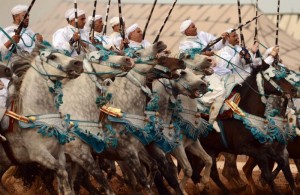AFP
AFP/File / Fadel Senna
The equestrian art of tbourida in Morocco was above all the fusion of man and horse, especially the Barb, an ancient North African breed famed for its hardiness and stamina.
The equestrian art of tbourida, inspired by the historical charges of the feared cavalrymen of Morocco, fascinated Romantic painter Eugene Delacroix two centuries ago and still draws enthusiastic crowds today.
At this week’s “Salon du Cheval” show in El-Jadida, western Morocco, thousands have been enthralled by the spectacle of groups of riders in colourful traditional dress charging in a line and then suddenly coming to a halt with a synchronised firing of their muskets in a deafening and pungent blast of gunpowder.
The 15 finest troops of cavalrymen from across the North African country competed in the first King Mohammed VI Grand Prix of tbourida, taken from the word for gunpowder in a local dialect, at the sandy exhibition grounds of the port city of El-Jadida.
The event showcased “the traditional equestrian art of Morocco dating back to the 13th century”, Hamid Benazzou, who heads an association on Moroccan horses, told AFP.
AFP/File / Fadel Senna
The 15 finest troops of cavalrymen from across Morocco compete in the first King Mohammed VI Grand Prix of Tbourida in the port city of El-Jadida
Mustapha Mallagui, 42, a civil servant and part-time farmer who rides with the “sorba”, or troop, from Fes-Meknes in central Morocco, said “tbourida and its horses are like a work of art”, as seen in many magnificent paintings by the French master Delacroix.
“Historically, (Arab and Berber) tribes would celebrate victories with the tbourida to display their equestrian knowhow, their handling of guns, the beauty of their harnesses. It was a sort of military parade,” Mallagui said, standing under one of the huge red-carpeted tents set up for competitors.
Today, the tribal wars are over but the rituals remain a part of traditional festivities in the countryside. Villages and towns all have their own sorba and a nationwide contest selects the best troop from each region.
The colourful harnesses of the horses, the regional costumes of the riders are a sight for the eyes, with their embroidery, kaftans, pompoms, the “burnous” Arab hooded cloaks, shoulder belts and turbans.
Shiny curved daggers, swords, powder horns and pearl-encrusted guns with chiselled grips add to the visual feast of handicrafts.
– Fusion of man and horse –
The tradition of tbourida is deeply-ingrained in central Morocco and the southern deserts, where cavalrymen in their majestic blue “gandoura” tunics fire not in the air but into the ground because, as Mallagui explained, “the enemy is hidden in the sand and not in the mountains”.
“Before, there were no tanks, no planes in wars… there was only the horse,” he said.
Tbourida was above all the fusion of man and horse, especially the Barb, an ancient North African breed famed for its hardiness and stamina.
AFP/File / Fadel Senna
The tradition of tbourida is deeply-ingrained in central Morocco and the southern deserts
It was introduced to Europe centuries ago and became the favoured horse of royal courts and on the battlefield right up to the time of Napoleon.
Each sorba is made up of between 11 and 15 riders, mounted proud and straight-backed, with a captain at the centre who loudly coordinates the movements of his men and horses.
The troop makes a first pass, called the “hadda”, at a slow gait followed by a trot, to exhibit their equipment and their mastery of beast and weapons.
The “talqa”, or charge, is next with a synchronised gallop that comes to a finale with simultaneous firing of the muskets at the captain’s command before the horses come to a sudden standstill right in front of the jury.
Errors are common, with riders falling off their horse or guns failing to fire. “To be a sorba rider, you need the discipline of a soldier,” one of them said as the two-hour spectacle drew to a close.








